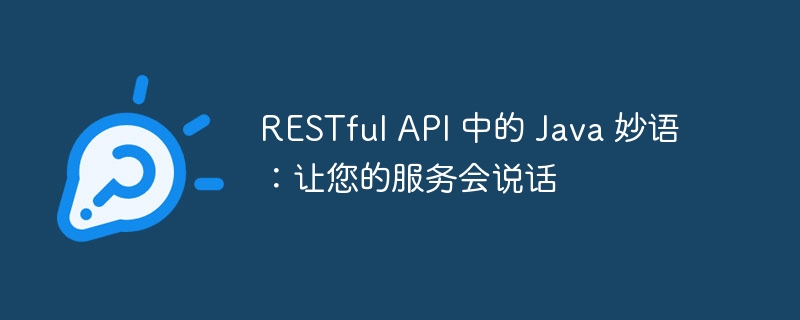Java Quiz in RESTful APIs: Let your services speak

Java Quiz in RESTful APIs: Let your services speak RESTful API is a design style that provides services through concise URLs and HTTP methods. Java, a popular programming language, is widely used to develop RESTful APIs. In Java, through reasonable design and coding practices, you can make your services more "speakable" and provide a better user experience. This article will take you deep into the Java quip of RESTful APIs and help you better understand and apply this technology.
Jackson Framework provides a comprehensive set of tools for processing JSON data. Its Data Binding module allows you to easily map Java objects to jsON representations, which is essential for building responses and deserializing requests.
Use Swagger/OpenAPI to generate documentation:
Theswagger and Openapi specification is an industry standard for defining and documenting RESTful APIs. The springfox library allows you to easily generate Swagger documentation for your API, which is critical for providing interactive documentation to developers.
Use Spring WebMvc for controller processing:
SpringWEBmvc The framework provides convenient methods for creating RESTful API controllers. By using annotations such as @RestController and @RequestMapping, you can easily define routes and handle Http requests.
Introducing Spring Data REST for rapid API development:
The Spring Data REST module provides a quick and easy way to create a REST-based API for interacting withdatabase entities. It automatically generates controllers and endpoints, saving a lot of coding time.
Use Lombok to simplify the code:
Lombok is a Java library that helps you simplify your code, thereby reducing boilerplate code by automatically generating getters, setters, and constructors. This makes it easier to write clear and maintainable API code.
Using JUnit and Mockito for testing:
Testing is key to ensuring the stability and reliability of your API. Libraries like JUnit and Mockito provide comprehensive tools for unit and integration testing of controllers, services, and endpoints.
API debugging via HTTPie or Postman:
HTTPie and Postman is an API debugging tool that helps you send requests, inspect responses, and explore API functionality. These tools provide an interactive interface that allows you to easily test and verify your API.
Use Swagger UI and Springfox-Swagger2 for UI documentation:
Swagger UI and the Springfox-Swagger2 library can generate interactive user interface documentation that contains API definitions, endpoint descriptions, and sample requests. This is useful for providing easy-to-understand documentation to developers and users.
Best Practices:
- Use concise and meaningful resource names.
- Follow HTTP status code conventions for communicating errors and success responses.
- Provide a detailed response explaining the results of request processing.
- Use versioning to maintain API compatibility.
- Implement
- security security measures to protect the API from unauthorized access.
The above is the detailed content of Java Quiz in RESTful APIs: Let your services speak. For more information, please follow other related articles on the PHP Chinese website!

Hot AI Tools

Undresser.AI Undress
AI-powered app for creating realistic nude photos

AI Clothes Remover
Online AI tool for removing clothes from photos.

Undress AI Tool
Undress images for free

Clothoff.io
AI clothes remover

AI Hentai Generator
Generate AI Hentai for free.

Hot Article

Hot Tools

Notepad++7.3.1
Easy-to-use and free code editor

SublimeText3 Chinese version
Chinese version, very easy to use

Zend Studio 13.0.1
Powerful PHP integrated development environment

Dreamweaver CS6
Visual web development tools

SublimeText3 Mac version
God-level code editing software (SublimeText3)

Hot Topics
 1378
1378
 52
52
 How does Java's classloading mechanism work, including different classloaders and their delegation models?
Mar 17, 2025 pm 05:35 PM
How does Java's classloading mechanism work, including different classloaders and their delegation models?
Mar 17, 2025 pm 05:35 PM
Java's classloading involves loading, linking, and initializing classes using a hierarchical system with Bootstrap, Extension, and Application classloaders. The parent delegation model ensures core classes are loaded first, affecting custom class loa
 How do I implement multi-level caching in Java applications using libraries like Caffeine or Guava Cache?
Mar 17, 2025 pm 05:44 PM
How do I implement multi-level caching in Java applications using libraries like Caffeine or Guava Cache?
Mar 17, 2025 pm 05:44 PM
The article discusses implementing multi-level caching in Java using Caffeine and Guava Cache to enhance application performance. It covers setup, integration, and performance benefits, along with configuration and eviction policy management best pra
 How can I use JPA (Java Persistence API) for object-relational mapping with advanced features like caching and lazy loading?
Mar 17, 2025 pm 05:43 PM
How can I use JPA (Java Persistence API) for object-relational mapping with advanced features like caching and lazy loading?
Mar 17, 2025 pm 05:43 PM
The article discusses using JPA for object-relational mapping with advanced features like caching and lazy loading. It covers setup, entity mapping, and best practices for optimizing performance while highlighting potential pitfalls.[159 characters]
 How do I use Maven or Gradle for advanced Java project management, build automation, and dependency resolution?
Mar 17, 2025 pm 05:46 PM
How do I use Maven or Gradle for advanced Java project management, build automation, and dependency resolution?
Mar 17, 2025 pm 05:46 PM
The article discusses using Maven and Gradle for Java project management, build automation, and dependency resolution, comparing their approaches and optimization strategies.
 How do I create and use custom Java libraries (JAR files) with proper versioning and dependency management?
Mar 17, 2025 pm 05:45 PM
How do I create and use custom Java libraries (JAR files) with proper versioning and dependency management?
Mar 17, 2025 pm 05:45 PM
The article discusses creating and using custom Java libraries (JAR files) with proper versioning and dependency management, using tools like Maven and Gradle.




